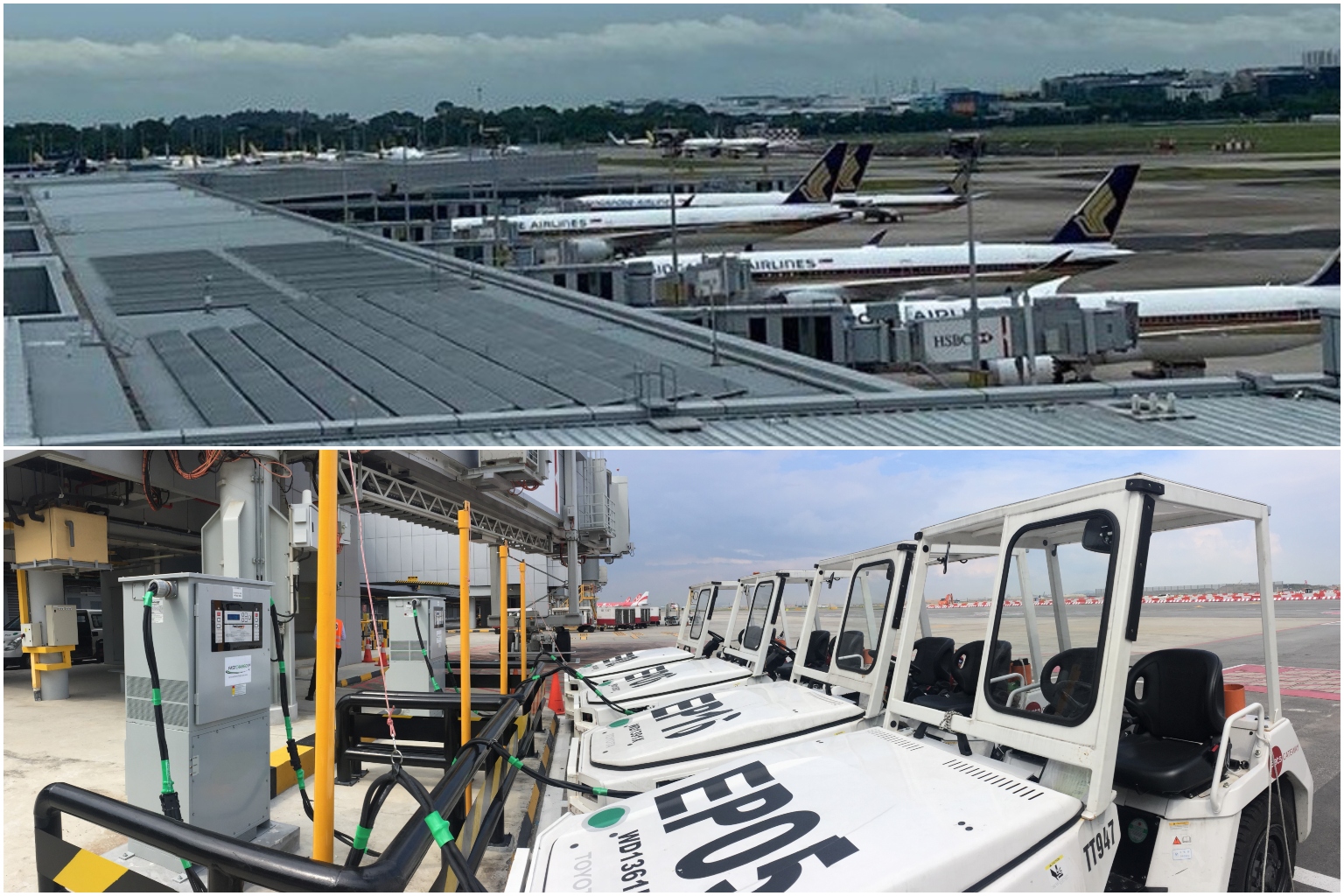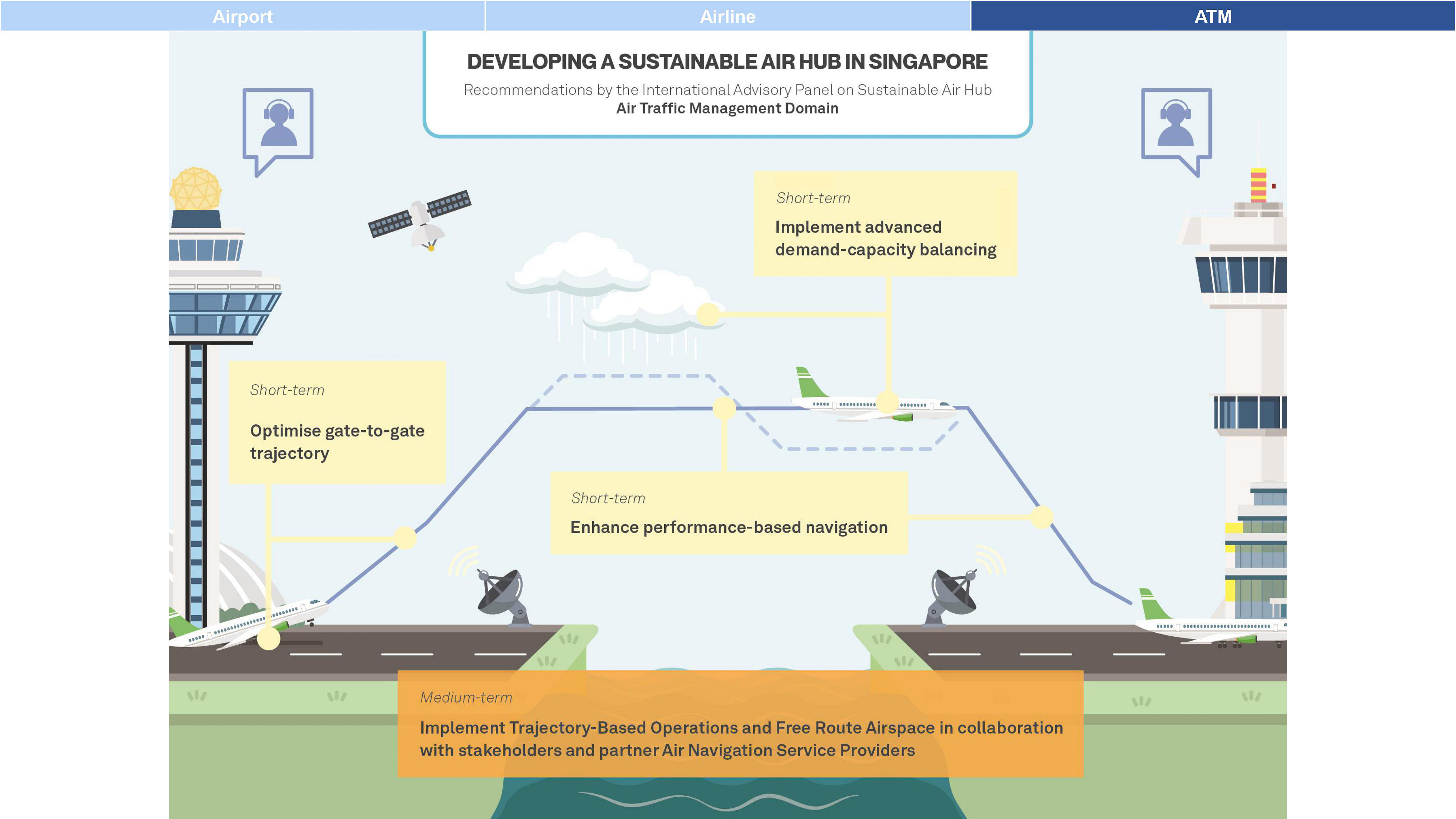International panel unveils plans to make Changi air hub greener
Sign up now: Get ST's newsletters delivered to your inbox

Solar panels on Changi Airport Terminal 3 and baggage tractors at Terminal 4 that run on battery power.
PHOTOS: CHANGI AIRPORT GROUP
Follow topic:
SINGAPORE - Cleaner vehicles, better cooling systems at terminals and the installation of solar panels in open spaces around Changi Airport's runways.
These are among the proposals mooted by an international panel of experts and business representatives to reduce the carbon footprint of Singapore's aviation sector.
In a report it submitted to the Government on Friday, the 20-member panel gave 15 recommendations on how to make the airport, airlines and air traffic management here greener.
The Government will study its proposals, and incorporate them into a blueprint that outlines Singapore's 2030 and 2050 goals for a greener air hub which will be published in 2023.
The report comes as the global aviation industry moves to decarbonise to address climate change, which the panel said is "an existential issue that impacts air travel directly".
It is untenable for the aviation industry to remain on its current trajectory, the panel said, noting that the sector's contribution to global emissions is estimated to increase significantly from 2 per cent before the pandemic to 22 per cent if nothing is done.
It is untenable for the aviation industry to remain on its current trajectory, the panel said, noting that the sector's contribution to global emissions is estimated to increase significantly from 2 per cent before the pandemic to 22 per cent if nothing is done.
Transport Minister S. Iswaran on Friday said the report and the upcoming blueprint are clear signals of Singapore’s commitment to sustainability, which in turn will give the Republic an edge over other air hubs.
The panel - which was formed in February and consulted more than 120 representatives from 40 industry players over six months - said airport operations are highly energy intensive, and proposed six ways that Changi can reduce its footprint.
The panel - which was formed in February and consulted more than 120 representatives from 40 industry players over six months - said airport operations are highly energy intensive, and proposed six ways that Changi can reduce its footprint.
One is to replace the existing fleet of about 2,000 to 3,000 vehicles used for airside operations with cleaner alternatives, such as fully electric or hydrogen-powered vehicles.
About 10 per cent of Changi Airport's airside vehicles are already fully electric, and there are more than 100 charging points available across the four terminals.
For instance, baggage tractors at Terminal 4 now run on battery power.
For larger vehicles that are harder to convert, such as catering trucks, the panel mooted using renewable diesel made from animal fats, food waste and plant oils.
The panel also found that air-conditioning consumes the most electricity at Changi Airport, accounting for 60 per cent of the power used by the four terminals.
Work is being done to reduce this, including upgrading existing air-conditioning systems and using solar films on windows. But the panel said other solutions like district cooling can be adopted to make air-conditioning at the airport more efficient. Detailed assessments should be done over the next two years, including trials.
These alternative cooling methods can then be included in the design of the upcoming Terminal 5 to achieve maximum energy savings, the panel said.
Changi Airport should also maximise solar power use by looking at whether it can install solar panels on untapped open spaces within the airfield, the panel added.

The airport currently has rooftop solar panels that have a total capacity of 22 megawatt-peak - 4 per cent of Changi's pre-Covid-19 energy use.
Installing solar panels on water bodies and open areas surrounding the airport's runways could help meet an additional 5 per cent of its energy needs.
However, the report also flagged possible safety risks, including glare from the solar panels affecting air traffic controllers and pilots. Another issue is whether these solar panels can generate enough electricity to be commercially viable.
The Civil Aviation Authority of Singapore (CAAS) should conduct a technical assessment of this proposal, the panel said.

CAAS should also try to secure imported low-carbon electricity for the airport, and a study should be done to see if it is feasible to establish a facility that can convert waste material into fuel or electricity, the panel said.
On the air traffic management front, the panel said new technology and operating procedures can help to reduce unnecessary fuel burn and emissions by facilitating more direct flight routes, among other things.
These improvements could also benefit passengers by minimising delays.
The panel gave three recommendations it said could be implemented within the next four years, and a fourth that could come into play some time from 2027 to 2032.
The proposals include studies on ways to improve the reliability and timeliness of weather information provided to pilots and air traffic controllers.

For airlines, the panel gave five recommendations centred on promoting the adoption of sustainable aviation fuel and new aircraft technology.
One is the need for Changi Airport to develop a long-term secured supply ecosystem for sustainable aviation fuel, which has been touted as the most promising near-term solution to significantly reduce carbon emissions from planes.
It is produced from renewable raw materials, such as used cooking oil or animal fats, but costs three to five times more than conventional jet fuel.

Since July, Singapore Airlines and Scoot flights out of Changi Airport have started using a blend of regular jet fuel and sustainable aviation fuel in a one-year trial.
Carbon credits tied to the use of sustainable aviation fuel have also been sold as part of a pilot scheme.
While the panel said its 15 recommendations will allow Singapore to distinguish itself from other air hubs, it also flagged the potential for higher costs.
As an early adopter, the Republic will need to be wary about possibly compromising the air hub's competitiveness, the panel said. For instance, high sustainable aviation fuel premiums could distort pricing and result in an uneven playing field.
Asked about this, Mr Iswaran said: “Various air hubs around the world will seek to differentiate themselves, and those who are able to implement effectively a sustainability programme are the ones that will really command greater attention.”
Travellers will be closely scrutinising what different air hubs and airlines are doing, so even if it means slightly higher costs, “it will also have an important competitive dividend payout”, he told reporters on the sidelines of a Singapore Shipping Association gala dinner at Sands Expo and Convention Centre.
“We will work with the industry to see where we need to give further help,” he added.
Asked about this, Mr Iswaran said: “Various air hubs around the world will seek to differentiate themselves, and those who are able to implement effectively a sustainability programme are the ones that will really command greater attention.”
Travellers will be closely scrutinising what different air hubs and airlines are doing, so even if it means slightly higher costs, “it will also have an important competitive dividend payout”, he told reporters on the sidelines of a Singapore Shipping Association gala dinner at Sands Expo and Convention Centre.
“We will work with the industry to see where we need to give further help,” he added.
15 ways for aviation to go green
An international panel submitted a report on Friday detailing 15 ways Singapore's aviation sector can tackle climate change.
The panel also highlighted four critical enablers, including workforce transformation.
Here are the proposals.
Airport
Airfield solar panels
Do a technical study to see if it is feasible to put solar panels on the airfield in Changi Airport.
Do a technical study to see if it is feasible to put solar panels on the airfield in Changi Airport.
Renewable energy
The Civil Aviation Authority of Singapore (CAAS) should secure green energy for the airport and tap new domestic production initiatives such as carbon capture.
The Civil Aviation Authority of Singapore (CAAS) should secure green energy for the airport and tap new domestic production initiatives such as carbon capture.
Air-conditioning
Use innovative technologies and design concepts to improve energy efficiency when cooling terminals.
Use innovative technologies and design concepts to improve energy efficiency when cooling terminals.
Cleaner airside vehicles
Facilitate the transition to cleaner energy options. Conduct a study and trials to understand the challenges.
Facilitate the transition to cleaner energy options. Conduct a study and trials to understand the challenges.
Waste-to-energy facility
Study the viability of generating biofuels or electricity from waste at the airport.
Study the viability of generating biofuels or electricity from waste at the airport.
Optimise airport operations
Study the use of a digital replica of actual airport operations to optimise processes and make predictions.
Study the use of a digital replica of actual airport operations to optimise processes and make predictions.
Airlines
Sustainable aviation fuel (SAF)
Set up a long-term supply ecosystem, including sourcing feedstock within the region.
Set up a long-term supply ecosystem, including sourcing feedstock within the region.
Carbon offsets
Work with key players in the carbon services sector to build up a market for aviation carbon offsets.
Work with key players in the carbon services sector to build up a market for aviation carbon offsets.
Buyers' club for SAF
Establish a buyers' club to encourage business travellers and air cargo users in the region to become early adopters of sustainable air travel.
Establish a buyers' club to encourage business travellers and air cargo users in the region to become early adopters of sustainable air travel.
Create demand for SAF
Introduce mechanisms such as mandates and incentives to spur use of sustainable aviation fuel.
Introduce mechanisms such as mandates and incentives to spur use of sustainable aviation fuel.
Technical centre
Work with aircraft manufacturers and tap the research and development ecosystem here to stay at the forefront of aircraft technology advances.
Work with aircraft manufacturers and tap the research and development ecosystem here to stay at the forefront of aircraft technology advances.
Air traffic management
Short term (2022-2026) Demand-capacity balancing
Work with air navigation service providers in the Asia-Pacific to better coordinate and manage longer-haul flights; better integrate weather information with air traffic management decisions.
Work with air navigation service providers in the Asia-Pacific to better coordinate and manage longer-haul flights; better integrate weather information with air traffic management decisions.
Performance-based navigation
Formalise implementation of more direct point-to-point routes for arriving planes on specific segments by 2023; develop smart tools to allow planes to descend continuously into Changi Airport, rather than in steps.
Formalise implementation of more direct point-to-point routes for arriving planes on specific segments by 2023; develop smart tools to allow planes to descend continuously into Changi Airport, rather than in steps.
Gate-to-gate trajectory
Put in place building blocks for trajectory-based operations, where flight trajectories from one airport gate to a different airport's gate are planned ahead of time and executed more precisely - a fundamental shift from the current reliance on tactical air traffic control.
Put in place building blocks for trajectory-based operations, where flight trajectories from one airport gate to a different airport's gate are planned ahead of time and executed more precisely - a fundamental shift from the current reliance on tactical air traffic control.
Medium term (2027-2032) Implement free-route airspace
CAAS should work with air navigation service providers to further explore the implementation of free-route airspace, where pilots can choose the most optimal route in terms of flight and fuel efficiency, instead of following a set path.
CAAS should work with air navigation service providers to further explore the implementation of free-route airspace, where pilots can choose the most optimal route in terms of flight and fuel efficiency, instead of following a set path.

